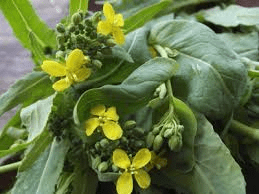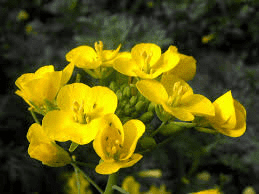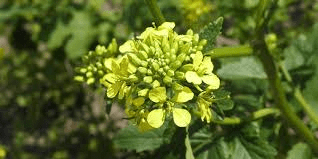Turnip flowers are the reproductive structures of the turnip plant (Brassica rapa subsp. rapa) and emerge as part of the plant’s flowering phase. These flowers are a key component of the plant’s life cycle, facilitating reproduction through the production of seeds.
Turnip flowers are small and typically have a bright yellow color. Each flower has four petals arranged in a cross shape, which is characteristic of plants in the Brassicaceae family, commonly known as the mustard or cabbage family. This cross-shaped arrangement is one of the defining features of the family. The flowers also possess six stamens, which are the male reproductive organs that produce pollen. The pistil, or female reproductive part, is located at the center of the flower and consists of the stigma, style, and ovary.
The flowering process begins when the plant bolts, or sends up a flowering stalk from the top of the plant. This bolting often occurs in response to environmental factors such as changes in temperature or daylight. The flowering stalk, known as a raceme, is a type of inflorescence where the flowers are arranged along a central stem.
Pollination is a crucial step in the flowering process. Turnip flowers are typically pollinated by insects such as bees, which transfer pollen from the stamens of one flower to the pistils of another. This transfer of pollen leads to fertilization, resulting in the formation of seeds within the flower’s ovary. After pollination, the flowers develop into seed pods or siliques, which are elongated capsules that contain the seeds.
Turnip flowers can be used in culinary applications, though they are less commonly consumed compared to the plant’s roots and leaves. The young flower buds and unopened flowers have a mild, slightly spicy flavor that can be enjoyed in various dishes. They can be sautéed, steamed, or added to salads for a unique flavor and nutritional boost.
In terms of plant biology, the development of flowers is an important part of the turnip’s reproductive strategy. Once the plant reaches maturity and produces flowers, it shifts its focus from growing the root to ensuring successful reproduction. The seeds produced by the flowers are dispersed, either through natural means such as wind or animal activity or through human intervention. These seeds can then germinate and grow into new turnip plants, continuing the life cycle of the species.
In agriculture, the presence of flowers on turnip plants indicates that they are in the final stages of their growth cycle. For crops grown primarily for their roots, such as turnips, flowering is often an undesirable trait because it can lead to a decline in root quality and flavor. Farmers and gardeners typically aim to harvest turnips before they begin to flower to ensure the best quality of the root vegetables.
Turnip flowers are small, yellow blossoms that play a critical role in the reproductive phase of the turnip plant. They facilitate pollination and seed production, which are essential for the continuation of the plant species. While not as commonly consumed as the roots or leaves, turnip flowers offer unique culinary uses and contribute to the plant’s overall growth and reproduction.
The Economic Importance and Uses of Turnip Flowers

1. Edible Flowers: Turnip flowers are edible and can be used to enhance the flavor and presentation of salads, soups, and other dishes.
2. Culinary Innovation: They offer chefs a unique ingredient for creating innovative and visually appealing dishes, contributing to the culinary arts.
3. Nutritional Benefits: Turnip flowers are rich in vitamins and antioxidants, adding nutritional value to meals.
4. Market Appeal: Their use in gourmet cuisine can increase the market value of turnip crops by diversifying their applications.
5. Aesthetic Value: Turnip flowers are used in floral arrangements and as garnishes, adding beauty and elegance to culinary presentations.
6. Pollinator Support: These flowers attract beneficial pollinators like bees and butterflies, which can improve overall garden health and productivity.
7. Organic Farming: Turnip flowers are suitable for organic farming and help support a sustainable agricultural ecosystem.
8. Specialty Products: They can be used to create specialty food products, such as herbal teas and floral syrups, adding value to turnip crops.
9. Educational Use: Turnip flowers are used in educational settings to teach about plant biology, horticulture, and the importance of pollinators.
10. Community Gardens: They are popular in community gardens, providing both aesthetic and nutritional benefits.
11. Medicinal Uses: In traditional medicine, turnip flowers may be used for their potential health benefits, including anti-inflammatory and detoxifying properties.
12. Research Opportunities: They are studied for their potential applications in food products and natural remedies.
13. Culinary Education: Turnip flowers are used in culinary programs to teach about the use of edible flowers in cooking.
14. Seasonal Products: They are often used in seasonal dishes and products, offering a unique touch to festive or specialty foods.
15. Food Presentation: Turnip flowers can enhance the visual appeal of dishes, making them more attractive and appealing to diners.
16. Floral Decor: They are used in decorative arrangements and as part of gourmet food presentations, adding a touch of elegance.
17. Pollinator Habitat: Growing turnip flowers helps support local ecosystems by providing habitats for pollinators.
18. Economic Diversification: By adding turnip flowers to their crop offerings, farmers can diversify their products and income sources.
Read Also: Ideal Feeds for Young and Adult Ruminant Animals
The Products and By-products That Can Be Derived From Turnip Flowers

1. Edible Flowers: Used fresh in salads and as garnishes in various dishes.
2. Floral Teas: Infused into herbal teas for their unique flavor and potential health benefits.
3. Floral Syrups: Used to make syrups for beverages and desserts, adding a floral note.
4. Flower Preserves: Turnip flowers can be used to make jams and preserves, offering a unique flavor profile.
5. Turnip Flower Vinegar: Infused into vinegar to add a subtle floral flavor to dressings and sauces.
6. Turnip Flower Extracts: Extracted for use in culinary applications or natural remedies.
7. Floral Ice Cubes: Incorporated into ice cubes for decorative purposes in beverages.
8. Culinary Oils: Infused into oils for use in cooking and dressing, adding a floral flavor.
9. Potpourri: Dried turnip flowers can be used in potpourri for aromatic and decorative purposes.
10. Essential Oils: Extracted to create essential oils for use in aromatherapy and personal care products.
11. Flower Salves: Used in homemade salves or balms for their potential therapeutic properties.
12. Specialty Baked Goods: Incorporated into baked goods for a unique flavor and appearance.
13. Herbal Supplements: Processed into supplements or capsules for their potential health benefits.
14. Turnip Flower Jellies: Made into jellies or candies for a unique treat.
15. Floral Decor: Used in decorative arrangements and as part of gourmet food presentations.
16. Turnip Flower Flours: Dried and ground into flours for baking applications.
17. Flower Essences: Used to create flower essences for alternative medicine and personal use.
Read Also: How to control Ruminants from destroying Grasses where they graze
Frequently Asked Questions (FAQ’s) About Turnip Flowers

1. What are turnip flowers?
Turnip flowers are the blooming parts of the turnip plant, which are edible and can be used in a variety of culinary applications.
2. How can turnip flowers be used in cooking?
Turnip flowers can be used fresh in salads, as garnishes, or incorporated into specialty products like syrups and teas.
3. Are turnip flowers nutritious?
Yes, turnip flowers are rich in vitamins, antioxidants, and other nutrients, making them a healthy addition to your diet.
4. How quickly do turnip flowers bloom?
Turnip flowers typically bloom a few weeks after the plant begins flowering, usually within 8 to 10 weeks from planting.
5. Can turnip flowers be grown indoors?
Yes, turnip flowers can be grown indoors in containers with proper light and care.
6. Are turnip flowers suitable for organic farming?
Yes, turnip flowers are suitable for organic farming and can support sustainable agricultural practices.
7. What are some common uses for turnip flowers?
Common uses include culinary applications, herbal teas, syrups, floral decor, and specialty products.
8. How should turnip flowers be stored?
Fresh turnip flowers should be stored in the refrigerator in a damp paper towel or container to keep them fresh.
9. Can turnip flowers be preserved?
Yes, turnip flowers can be dried, preserved, or used in products like jams and syrups.
10. What are the potential health benefits of turnip flowers?
Turnip flowers may offer potential health benefits, including anti-inflammatory and antioxidant properties, and can be used in herbal remedies.
Read Also: Everything You Need to Know About Yarrow

